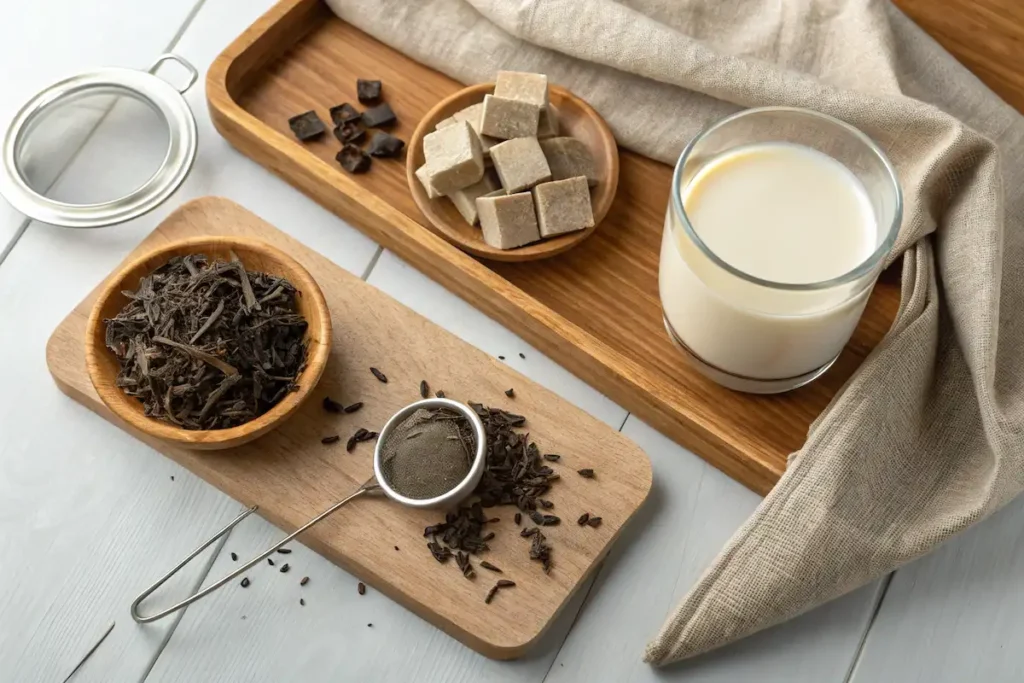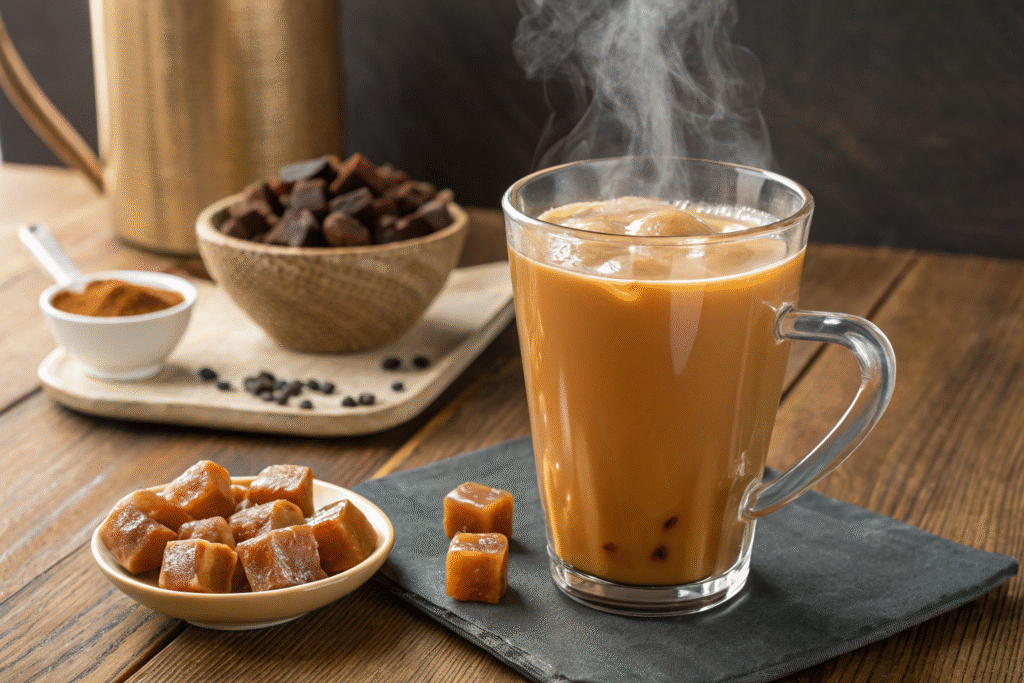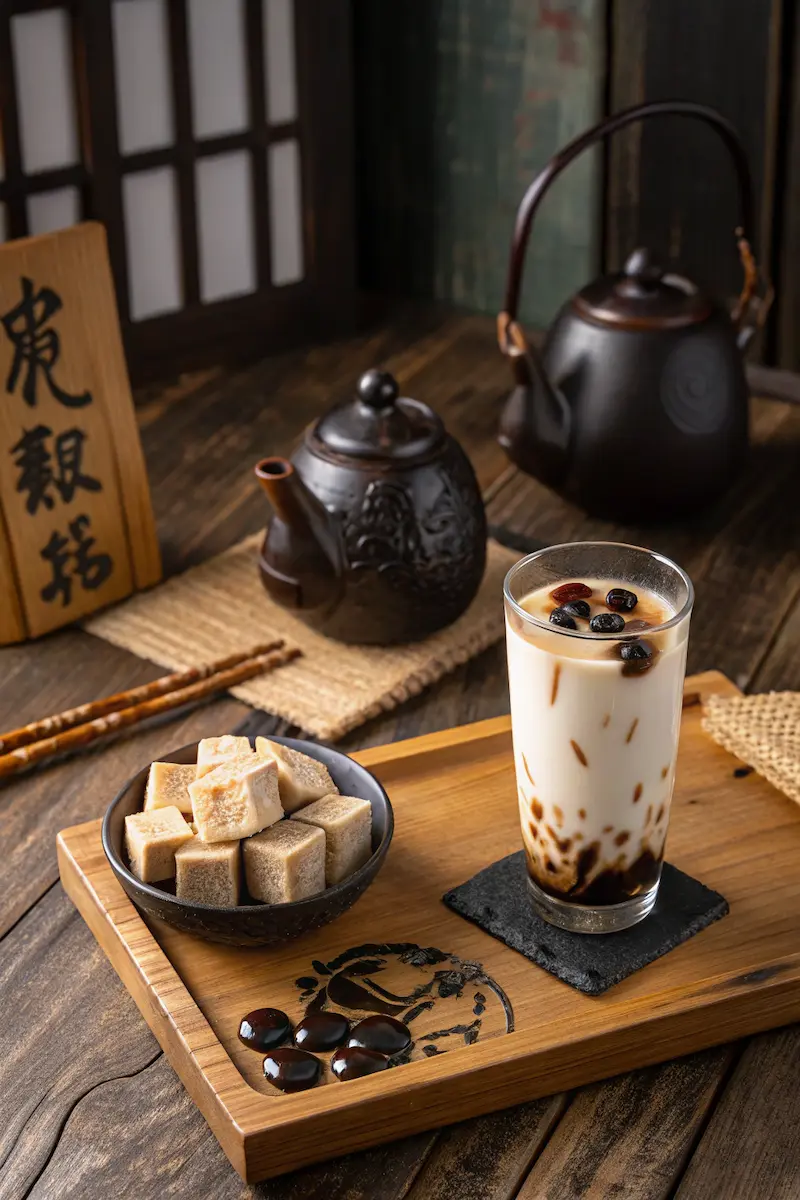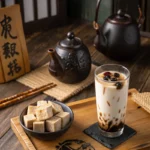If you’ve ever tasted something so warm and rich it made you pause — just for a second — you already understand what Okinawa Milk Tea is about. It’s not just another sweet milk tea. It’s deeper, darker, and more comforting. That roasted caramel flavor? That’s the heart of this drink — Okinawa’s own kokuto, a black sugar unlike any other.
I first tried it on a rainy day when I needed something grounding, and it instantly became one of my favorite ways to slow down. Whether you’re into bold, toasted notes or just curious about what makes this Japanese milk tea so special, this guide is for you.
Together, we’ll explore how kokuto transforms a simple tea into something soulful, how to make it hot or iced, and why this lesser-known cousin of Tiger Milk Tea deserves your full attention.
Table of Contents
Okinawa Milk Tea
Okinawa Milk Tea is a rich and comforting Japanese milk tea made with kokuto, a roasted black sugar unique to Okinawa, combined with bold black tea and creamy milk for a deeply satisfying drink.
- Prep Time: 5 minutes
- Cook Time: 5 minutes
- Total Time: 10 minutes
- Yield: 1 serving 1x
- Category: Drink
- Method: Stovetop
- Cuisine: Japanese
Ingredients
- 1 tbsp kokuto (or 2 tsp dark brown sugar)
- 1–2 tbsp water (for syrup)
- 1 tsp loose black tea (or 1 strong black tea bag)
- ¾ cup whole milk (or oat/soy milk)
- ½ cup water (for steeping tea)
- Optional: ice cubes (for iced version)
Instructions
- Simmer kokuto and 1–2 tbsp water over low heat until thick and glossy to create syrup. Set aside.
- Steep black tea in freshly boiled water for 3–5 minutes, then strain or remove bag.
- Warm milk gently until steaming, not boiling.
- In a mug, combine steeped tea and warm milk. Stir in kokuto syrup to taste and enjoy hot.
- For iced version: Brew strong tea and chill. Cool kokuto syrup. In a tall glass, swirl syrup, add ice, milk, and then chilled tea. Stir and serve.
Notes
Use Assam or Ceylon black tea for a bold base. Kokuto adds earthy, roasted depth—adjust syrup for desired sweetness.
Nutrition
- Serving Size: 1 cup
- Calories: 180
- Sugar: 14g
- Sodium: 80mg
- Fat: 6g
- Saturated Fat: 4g
- Unsaturated Fat: 1.5g
- Trans Fat: 0g
- Carbohydrates: 25g
- Fiber: 0g
- Protein: 4g
- Cholesterol: 20mg
The Heart of Okinawa: Kokuto’s Role in the Magic
What Is Kokuto? Okinawa’s Black Sugar Secret
Kokuto is where the magic starts. Unlike the brown sugar you’ll find in most kitchens, kokuto is unrefined, slow-cooked black sugar made from pure sugarcane juice — and only in Okinawa, Japan. It’s not processed the same way as commercial brown sugar. There’s no bleaching or refining. What you get instead is a block or chunk of rich, dark sugar with deep molasses tones, hints of smoke, and even nutty undertones.
Taste-wise, it’s not overly sweet. It’s earthy, bold, and even a little savory. That makes it perfect for roasted brown sugar milk tea lovers who want something more nuanced than the syrupy Tiger Milk Tea. Unlike the caramel used in Hokkaido Milk Tea, kokuto delivers complex roasted flavor with real depth.
I love grating or melting it slowly into a syrup. Once you smell it warming in the pan, you’ll understand exactly why this sugar has been treasured for centuries.
Kokuto’s Benefits Beyond Sweetness
In Okinawa, kokuto isn’t just a flavor — it’s part of the island’s philosophy of longevity and natural living. Why?
- Rich in Minerals: Because it’s minimally processed, kokuto retains iron, calcium, and potassium, offering more than just empty calories.
- Antioxidants: Like dark molasses, kokuto provides compounds that support cellular health.
- Natural Warmth: Many Okinawans believe in its ability to gently warm the body and aid digestion — something I absolutely feel after a cozy cup.
- Balanced Energy: Paired with black tea, which offers antioxidants and a light caffeine boost, it becomes a deeply satisfying and balanced pick-me-up.
→ If you’re curious about other wellness-centered teas, Coconut Milk Green Tea is another gentle favorite.
Foundation First: The Right Tea, Milk & Kokuto Prep
Choosing the Right Tea Base
For a drink as bold as Okinawa Milk Tea, you need tea that won’t get lost in the mix. My go-to? Assam black tea. It’s malty, rich, and stands tall next to kokuto’s intensity. Ceylon is another great choice — it brings briskness that contrasts nicely with the sugar’s deep sweetness.
Avoid delicate teas like white or green here — they’ll be drowned out.
→ Learn more about black tea strengths in Assam Milk Tea — it’s the ideal base for bold milk teas like this.
The Creamy Complement & Kokuto Prep
For that velvety mouthfeel, I recommend whole milk. But don’t worry — barista oat milk or unsweetened soy milk both work beautifully if you want a dairy-free Okinawa Milk Tea. These plant-based options keep the texture creamy without competing with kokuto’s profile.
To prep kokuto: gently melt it with a splash of water into a thick kokuto syrup. This concentrates the flavor and lets you control sweetness perfectly. Trust me — this step makes all the difference.

Let’s Brew: Okinawa Milk Tea Recipes You’ll Love
Authentic Hot Okinawa Milk Tea
This version is where the roasted notes truly shine. Here’s how I make it:
Ingredients
- 1 tbsp kokuto (grated or chopped, or 2 tsp dark brown sugar as sub)
- 1 tsp loose black tea (or 1 strong tea bag)
- ¾ cup whole milk (or oat/soy)
- ½ cup water
Instructions
- Make Kokuto Syrup
Simmer kokuto and 1–2 tbsp water over low heat until it forms a dark, glossy syrup. Set aside. - Steep Your Tea
Use freshly boiled water (200–212°F) and steep your black tea for 3–5 minutes. - Warm the Milk
Gently heat milk until steaming (don’t boil). - Assemble the Drink
In your mug, combine brewed tea and warm milk. Stir in kokuto syrup to taste. The result? A silky, caramel-toned tea with earthy depth.
→ Curious how this compares with similar drinks? You might enjoy the molasses swirls in Tiger Milk Tea, made with brown sugar syrup.
Iced Okinawa Milk Tea
When summer hits, I reach for this cold version — still bold, but totally refreshing.
How to do it:
- Brew a strong black tea and chill it completely.
- Prepare kokuto syrup as above and cool.
- In a tall glass, swirl syrup around the inner wall (classic Tiger-style), then fill with ice.
- Add milk and pour in the chilled tea.
Tip: Garnish with grated kokuto or a dusting of cinnamon for flair.
→ Need more iced tea inspiration? My Iced Green Milk Tea is a summer staple.
Boosting Flavor and Aesthetic
Want to take it further? Try:
- Vanilla extract (just a drop!) for roundness
- Sea salt pinch — it deepens kokuto’s caramel vibe, like a salted caramel latte
- Cinnamon or kokuto flakes on top for garnish
- Clear glass mug: The layered amber color looks stunning when served hot or iced
Variations & Culinary Pairings
Creative Okinawa Milk Tea Twists
This drink is so rich, it invites experimentation.
- Okinawa Boba Milk Tea: Add chewy tapioca pearls. The depth of kokuto matches perfectly with boba’s sweetness.
→ Curious how many calories this adds? Check out my Bubble Milk Tea Calories Guide. - Okinawa Matcha Fusion: Add a small swirl of matcha — it’s unexpected, earthy, and uniquely Japanese.
→ For full green tea flavor notes, visit Matcha Milk Tea. - Spiced Okinawa: Add a dash of ginger or star anise for warmth — perfect in winter.
- Okinawa Coffee Latte: Replace the tea with a strong espresso shot. Bold, bitter, and beautifully smoky-sweet.

What to Serve It With
I love sipping Okinawa Milk Tea with Japanese pastries, black sesame shortbread, or even a savory rice cracker. The sweetness and depth balance beautifully with subtle flavors — nothing too bold.
FAQ – Quick Sips of Clarity
What is in an Okinawa Milk Tea?
Okinawa Milk Tea is made with strong black tea (like Assam), rich milk (or plant-based options), and kokuto — a traditional roasted black sugar from Okinawa, Japan. That kokuto is what gives the drink its signature depth, with flavors of molasses, toast, and warm caramel.
What is the difference between Okinawa Milk Tea and classic milk tea?
The key difference lies in the sweetener. While classic milk tea often uses regular sugar or sweetened condensed milk, Okinawa Milk Tea uses kokuto, an unrefined Japanese black sugar. It brings a more roasted, earthy complexity you won’t find in standard classic milk tea.
What flavor is Okinawa?
When people describe the “Okinawa flavor,” they’re usually referring to the rich, roasted, slightly smoky sweetness of kokuto. It’s deeper than brown sugar — think toasted caramel meets molasses, with subtle mineral and umami undertones. That’s what makes Okinawa Milk Tea so special.
How to make Okinawa Milk Tea?
To make authentic Okinawa Milk Tea, brew a strong black tea base, prepare a kokuto syrup by melting the sugar with water, warm your milk (or use cold for iced), and combine. Stir well and adjust sweetness to taste.
→ Find the full step-by-step in the recipe section above — both hot and iced versions included!
Conclusion: Savor the Roasted Sweetness
Okinawa Milk Tea is more than a cozy drink — it’s an experience. One that starts with a rich, roasted sweetness and ends with a quiet kind of satisfaction. The kokuto brings complexity, the tea brings strength, and the milk rounds it all into something you’ll want to come back to.
If you’re ready to explore deeper flavors, this Japanese black sugar tea is the perfect place to begin. Let it warm your hands, your day, and maybe even your heart.
Warmly,
Rachel Moore



2 thoughts on “Okinawa Milk Tea – The Deep, Roasted Comfort You Didn’t Know You Needed”